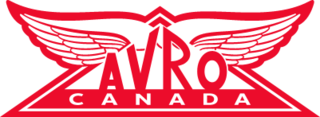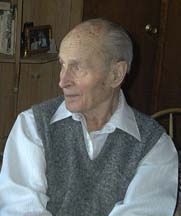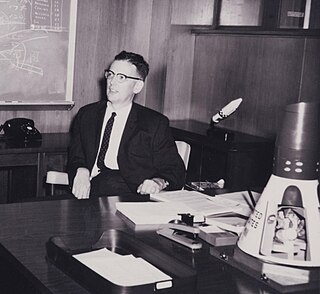
The Avro Canada CF-105 Arrow was a delta-winged interceptor aircraft designed and built by Avro Canada. The CF-105 held the promise of Mach 2 speeds at altitudes exceeding 50,000 feet (15,000 m) and was intended to serve as the Royal Canadian Air Force's (RCAF) primary interceptor into the 1960s and beyond.

Avro Canada was a Canadian aircraft manufacturing company. It was founded in 1945 as an aircraft plant and within 13 years became the third-largest company in Canada, one of the largest 100 companies in the world, and directly employing over 50,000. Avro Canada was best known for the CF-105 Arrow, but through growth and acquisition, it rapidly became a major, integrated company that had diverse holdings.

Janusz Żurakowski was a Polish fighter and test pilot. At various times in his life he lived and worked in Poland, the United Kingdom, and Canada.

Wendy Jane Crewson is a Canadian actress and producer. She began her career appearing on Canadian television, before her breakthrough role in 1991 dramatic film The Doctor.

Crawford Gordon Jr. was a leader of wartime defence production in Canada under Minister of Munitions and Supply C.D. Howe during the Second World War. He was perhaps one of the greatest industrialists and business minds in Canadian history; Gordon bought two companies and held one CEO position, but eventually lost it all.
Trudeau is a 2002 television miniseries and biography dramatizing the life of former Canadian Prime Minister Pierre Elliott Trudeau. It aired on CBC Television on Sunday and Monday evenings and was written by Wayne Grigsby and directed by Jerry Ciccoritti.

James Arthur Chamberlin was a Canadian engineer who contributed to the design of the Canadian Avro Arrow, NASA's Gemini spacecraft and the Apollo program. In addition to his pioneering air and space efforts, he is often cited as an example of Canadian brain drain to the U.S. In the early 1960s, he was one of the key people that proposed and moved that Lunar Orbit Rendezvous (LOR) was the best option for landing a crew on the Moon, the method eventually used on Apollo lunar landing missions. He left NASA in 1970 and worked for McDonnell Douglas, in their Houston offices, until his death in 1981.
Prairie Giant: The Tommy Douglas Story is a CBC Television miniseries first aired in two consecutive parts on March 12 and March 13, 2006. It dramatizes and fictionalizes the life and career of Tommy Douglas, the Canadian politician who oversaw the legislation of Canada's first public healthcare program as Premier of Saskatchewan. The production is directed by John N. Smith and produced by Kevin DeWalt with Minds Eye Entertainment.

Above and Beyond is a four-hour 2006 miniseries aired by the Canadian Broadcasting Corporation on October 29 and 30, 2006. It stars Richard E. Grant, Jonathan Scarfe, Liane Balaban, Allan Hawco, Kenneth Welsh and Jason Priestley. The miniseries deals with the Atlantic Ferry Organization, tasked with ferrying aircraft from North America to Europe in the early years of the Second World War.
Christian Duguay is a Canadian film director.

Diverted is a 2009 CBC made-for-TV miniseries. The film was directed by Alex Chapple based on the screenplay by Tony Marchant. Diverted is a fictionalized account inspired by what actually happened to the people of Gander, Newfoundland, and the passengers and crews on the airliners diverted by the Federal Aviation Administration (FAA) during the 9/11 attacks in Operation Yellow Ribbon.
The Academy of Canadian Cinema & Television's 9th Gemini Awards were held on March 5, 1995 to honour achievements in Canadian television. The awards show, which was hosted by Paul Gross and Tina Keeper, took place at the Metro Toronto Convention Centre and was broadcast on CBC Television.
Back Alley Film Productions is a television production company founded by Janis Lundman and Adrienne Mitchell and based in Toronto, Ontario, and Montreal, Quebec Canada. Founded in 1989, Back Alley is a creator and producer of original content for television with programming available in more than 120 countries worldwide.

The Aerospace Heritage Foundation of Canada is a federally chartered and non-profit organization based in Etobicoke, Toronto, Ontario, that is dedicated to preserving and promoting the achievements of the Canadian aerospace industry.

The Avro Canada CF-103 was a proposed Canadian interceptor, designed by Avro Canada in the early 1950s as a development, and possible replacement of the company's CF-100 Canuck, that was entering service at the time with the Royal Canadian Air Force (RCAF). Although intended to be capable of flying at transonic speeds, the CF-103 only offered a moderate increase in performance and capability over the CF-100; subsequently, the aircraft never progressed beyond the mock-up stage.
Dieppe is a two-part Canadian television miniseries that aired on CBC Television in 1993. It was based on the book Unauthorized Action: Mountbatten and the Dieppe Raid by Brian Loring Villa.

Net Worth is a 1995 Canadian biographical drama television film directed by Jerry Ciccoritti, based on the 1991 book Net Worth: Exploding the Myths of Pro Hockey by journalists David Cruise and Alison Griffiths. Starring Aidan Devine, Kevin Conway, R. H. Thomson, and Al Waxman, the film premiered on CBC on November 26, 1995.

Aidan Devine is an English–Canadian film actor. He was born in England and immigrated with his family to Canada at the age of 15. He studied at Dawson College's Dome Theatre in Montreal, Quebec and began his acting career in Montreal. He would later relocate to Toronto, Ontario. His 1993 breakout role came in Denys Arcand's, Love and Human Remains. Since then he has worked steadily in Canadian and American television and cinema capturing two Gemini Awards; a best actor award in 1997 for his performance as Ted Lindsay in Net Worth and in 1998, a best supporting actor Gemini for his performance as airframe engineer, Jim Chamberlin in The Arrow. He has been nominated three other times.
John A.: Birth of a Country is a Canadian historical drama television film directed by Jerry Ciccoritti and written by Bruce M. Smith. It was produced by Indian Grove Productions in association with the Canadian Broadcasting Corporation, and aired on CBC Television on September 19, 2011.
The Summit is a Canadian thriller drama television miniseries, which premiered in 2008. Directed by Nick Copus and written by John Krizanc, the miniseries centres on the preparations for an international Group of Seven summit of world leaders which is disrupted by a bioterrorism threat when mysterious forces plan to release an engineered drug-resistant strain of smallpox at the summit opening.











